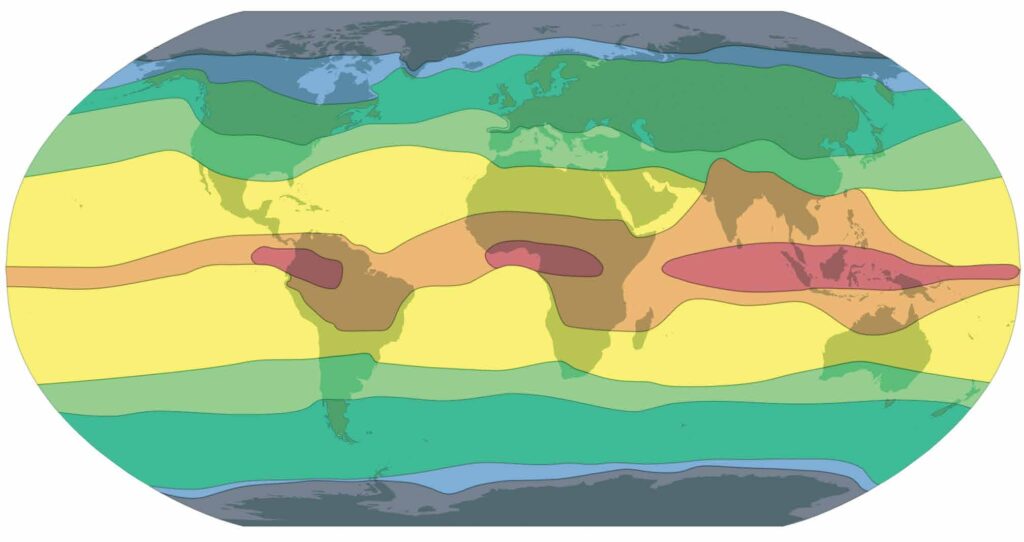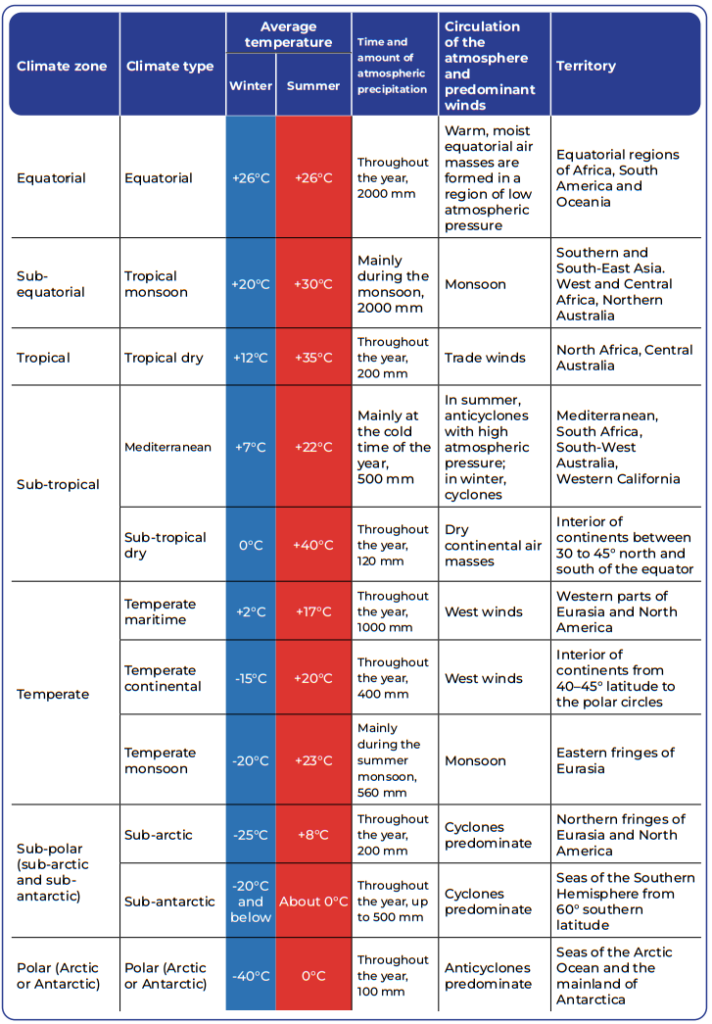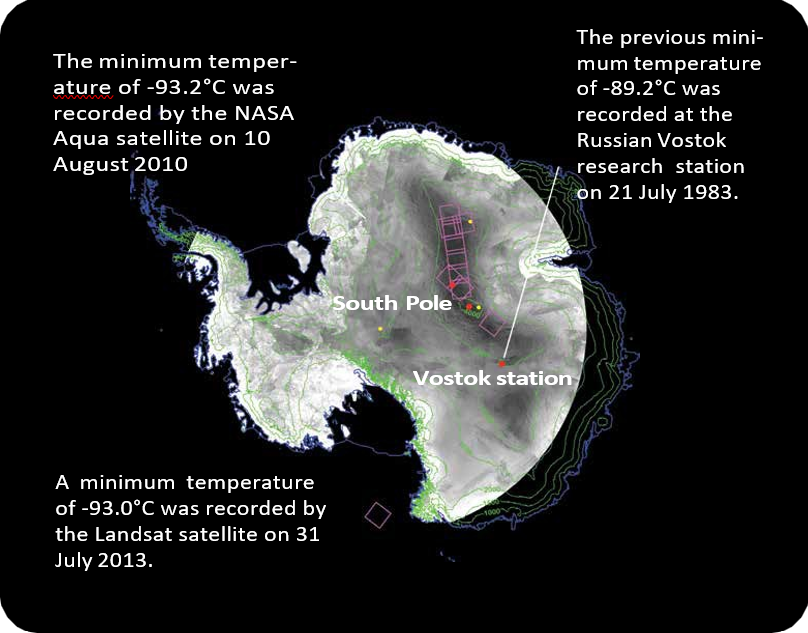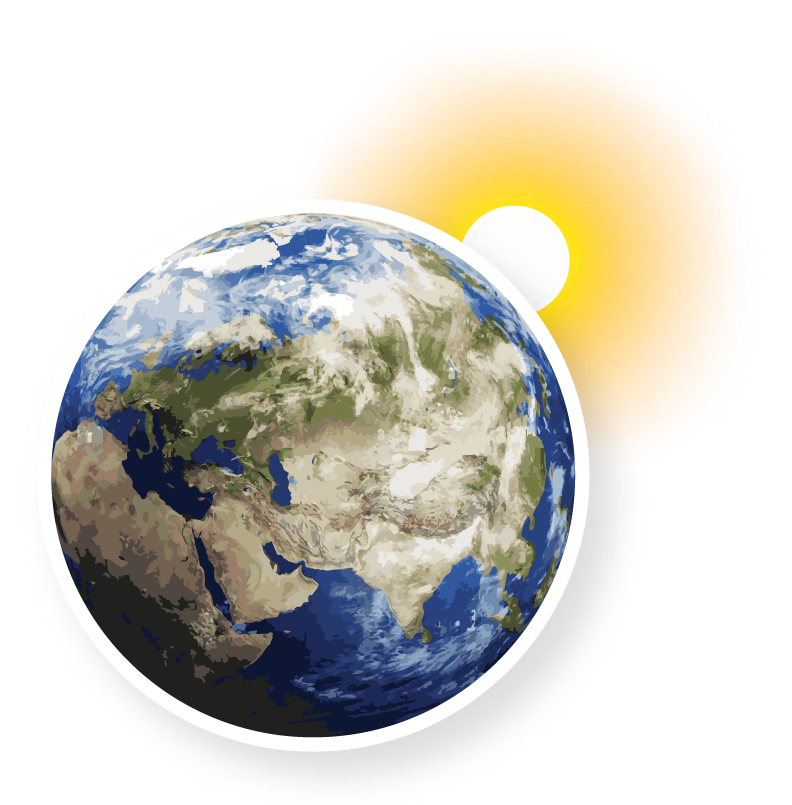Different parts of the globe have different climates. In northern countries, when people look out of the window during winter and see snow everywhere, they are keen to go on holiday to tropical countries, where one can enjoy hot weather and swim in the warm sea all year round.
Since ancient times, scientists have divided Earth into climate zones depending on the height of the sun above the horizon and the length of the day. The word ‘climate’ comes from the Greek language, in which it refers to the angle of inclination of the sun. Differences in the climate are primarily because the sun’s heat is distributed unevenly over the Earth’s surface. Proximity to the sea, atmospheric circulation, patterns of precipitation and other so- called ‘climate-forming factors’ also have a major role in determining climate, and they, in turn, depend much on geographical latitude and on the height above sea level.
Areas with similar climates are like broad stripes encircling the globe. They are what scientists call ‘climate zones’ and they turn colder the further away they are from the equator (Fig. 1.2.1).
2013.
Figure 1.2.1 The Earth’s climates (by Boris Alisov)

CLIMATE ZONES
are areas with a relatively uniform climate.
The most well-known classification of climates was introduced by a German Russian climatologist Wladimir Köppen in 1884 (Fig. 1.1.1). He divided the climates into five main types: A – Tropical, B – Dry, C – Temperate, D – Continental, E – Polar and Alpine.
Another system of climate classification, commonly used in Eastern Europe, was created in the 1950s by the Russian scientist Boris Alisov (Fig. 1.2.1). It defines four main climate zones in each hemisphere and three transitional zones.
The main climate zones are equatorial, tropical, temperate, and polar (Arctic in the Northern Hemisphere and Antarctic in the Southern Hemisphere). They are the main climate zones since each is dominated throughout the year by the same air masses.
Between the main climate zones are the transitional zones: sub-equatorial, sub-tropical and sub-polar (sub-Arctic in the Northern Hemisphere, and sub-Antarctic in the Southern Hemisphere). All the names of transitional climate zones have the prefix ‘sub’, which in Latin means ‘under’.
The air masses in transitional climate zones change with the seasons, entering them from neighbouring zones at various times of the year. For example, in a sub-tropical climate the summer is hot, like in the tropics, but the winter is cool, since the tropical air mass is displaced by an air mass from the temperate zone.
Some climate zones contain specific climate regions with a continental, maritime or monsoon climate (See Table 1.2.1).
The seasons in the southern and northern hemispheres are directly opposite: from December to February, when it is winter in the Northern Hemisphere, the Southern Hemisphere is in the midst of summer, and when the Northern Hemisphere is at its coldest, the Southern Hemisphere is at its hottest.
Table 1.2.1 Climates of Earth (by Boris Alisov)

A brief description of different climates

Equatorial climate
An equatorial climate is marked by hot and moist equatorial air masses. Air temperature is constant (+24–28°C) and there is much rain throughout the year (from 1500 to 5000 mm). Rain falls faster than water can evaporate from the ground, so the soil in an equatorial climate is waterlogged and covered by a dense and high rainforest. An equatorial climate is found in northern parts of South America, the coast of the Gulf of Guinea, in the Congo River basin and the headwaters of the Nile in Africa, over the greater part of the Indonesian archipelago and the adjacent parts of the Indian and Pacific Oceans in Asia.

Sub-equatorial climate
A sub-equatorial climate is marked by a rainy season in the summer, followed by a cool and dry season in the winter. Rainfall in a sub-equatorial climate is very uneven throughout the year. For example, Conakry (the capital of Guinea) receives just 15 mm of rain from December-March, but 3920 mm from June-September. This type of climate is found in some parts of the Indian Ocean, the western Pacific Ocean, as well as in South Asia and the tropical regions of Africa and South America.

Tropical climate
A tropical climate is dominated by anticyclones with high pressure, giving clear weather nearly all the year round. There are two seasons: warm and cold. Temperatures can vary from
+20°C on the coast to +50°C in the interior. The temperature can also vary greatly within a single day: on a summer afternoon the air heats up to +40–45°C but cools down at night to +10–15°C. Deserts are often found in tropical climates, and the largest is the Sahara Desert in Africa. Deciduous forests (forests that lose their leaves in the winter) and savannas are common in wetter regions. Mexico, North and South Africa, Central Australia and the Arabian Peninsula have a tropical climate.

Sub-tropical climate
A sub-tropical climate is found in regions between tropical and temperate latitudes, from about 30° to 45° north and south of the equator. They are marked by hot, tropical summers and cool winters. The average temperature in summer is above +22°C and in winter above -3°C, but the arrival of air from polar regions in wintertime may cause temperatures to drop to -10 to -15°C, and occasionally even as low as -25°C. This type of climate is typical for the Mediterranean, South Africa, Southwestern Australia and Northwestern California.

Temperate climate
A temperate climate is found in so-called temperate latitudes (from 40°–45° north and south of the equator as far as the polar circles). In the northern hemisphere more than half of the temperate zone is occupied by land rather than the sea. But 98% of the temperate zone in the southern hemisphere consists of ocean. A temperate climate is marked by frequent and severe weather changes due to cyclones. A temperate climate is characterized by four seasons, of which one is cold (winter), one is warm (summer) and the other two (spring and autumn) are transitional. The average temperature in the coldest month is usually below 0°C, and in the warmest month it is above +15°C. The ground is covered with snow in the winter. Prevailing westerly winds bring rain and snow throughout the year, with rainfall and snowfall varying from 1,000 mm in coastal areas to 100 mm deep inland.

Sub-polar (sub-Arctic, sub-Antarctic) climate
A sub-Arctic climate is found between Arctic and temperate climate zones in the northern hemisphere. This climate is marked by air masses at moderate temperature in the summer and cold air masses from the Arctic in the winter. The summers are short and chilly, with air temperature in July rarely above +15°C by day and dropping to 0°–+3°C at night, and frosty nights likely through the summer. In winter the temperature by day and night is -35°–45°C. The landscape in a sub-Arctic climate consists of tundra and forest tundra, the soil is marked by permafrost, and there are few plants and animals. The north of Russia and Canada, Alaska (USA), South Greenland and the far north of Europe have a sub- Arctic climate.
A sub-Antarctic climate is found in the southern hemisphere between the temperate and Antarctic zones. The greater part of the sub-Antarctic zone consists of ocean, with annual rain and snowfall up to 500 mm.

Polar (Arctic, Antarctic) climate
A polar climate is found to the north of 70° latitude in the northern hemisphere (Arctic climate) and to the south of 65° latitude in the southern hemisphere (Antarctic climate). Polar air masses are dominant all year round. The sun does not appear above the horizon for several months (this period is called the ‘polar night’) and during some other months it does not set beyond the horizon (‘midnight sun’ or ‘polar day’). Snow and ice reflect more heat than they absorb, so the air is very cold, and the snow never melts. Atmospheric pressure is high all year-round (anticyclone), so winds are weak and there are almost no clouds. There is very little snowfall, the air is full of small icy needles and a water haze often occurs in the summer. The average temperature in summer is below 0°C, and between -20°C and -40°C in winter.
Where are the coldest and hottest places on Earth?
The coldest place on Earth is the eastern plains of Antarctica. In August 2010, the US NASA Aqua satellite registered a new record low temperature there of -93.2°C (Figs. 1.2.2 and 1.2.3). However, this record is unlikely to be officially recognized because by current scientific standards air temperature must be measured on the Earth’s surface, and not from outer space, to be declared accurate. More recent analysis by NASA scientists shows that temperatures at the same location fell lower, to -98°C. So, the internationally recognized low temperature record remains -89.2°C, registered at the Soviet (now Russian) Vostok research station in Antarctica on 21 July 1983 (Fig. 1.2.4). The village of Oymyakon in eastern Siberia is the coldest permanently inhabited place on Earth, with average winter temperatures of
-50°C. The city’s coldest day on record was in 1924, when temperatures plunged to -71.2°C.
The hottest place on our planet is Death Valley in the USA where an absolute record air temperature in the shade of +56.7°C was registered on 13 July 1913 (Fig. 1.2.5). WMO is currently verifying two temperature measurements of +54.4°C, recorded at the same place, on 16 August 2020 and on 9 July 2021. If validated, this would be the highest temperature on Earth since 1913.
Figure 1.2.2
The American satellite NASA Aqua was launched in 2002 to study physical processes on Earth.

Figure 1.2.3
Surface air temperature in Antarctica: data from the US satellites NASA Aqua in 2003–2013 and Landsat 8 in 2013.

Figure 1.2.4 Russian research station Vostok in Antarctica

Figure 1.2.5 Death Valley, USA

QUESTIONS
1
When it is winter in the Northern Hemisphere, what time of year is it in the Southern Hemisphere?
2
What is wind? What types of winds do you know? What are the differences between them? In which climates do they predominate and why?
3
In which climate zone do you live? What do you know about the weather at different times of the year in your climate zone?
4
In which climate zones is it hardest for plants and animals to survive?
5
Where is it colder, at the North Pole or at the South Pole?
6
How fluent are you in climate terminology? Test yourself with the UNDP Climate Dictionary: https://www.undp.org/publications/climate-dictionary

TASKS

1
GAME
Materials: Cards showing various features of different types of climate: equatorial, tropical, temperate, polar. This is a game for 12–24 people. Each player receives one card with one climate feature.
Talk with other players and bring together all the features of one climate in one group of players. Mime to show the other groups what sort of climate you have.
2
The famous American writer Mark Twain once joked: “If you don’t like the weather in New England, just wait a few minutes.” What was it about the climate and weather in New England that the writer was making fun of?
Find New England on a map of the USA. Which climate zone is it in?
3
What are ‘favourable’ and ‘unfavourable’ climatic conditions? Divide into groups and choose one type of climate.
Make up play-acting and jokes about the type of climate you choose.
4
5
CROSSWORD
- One of the main
- The state of the atmosphere at a given time in a given
- Seasons come and go in ..
- Severe weather conditions with strong
- Frozen rain that falls in the form of small ice balls or
- A long-term weather pattern at a certain period of the
- One of the main features of
- The main character of children’s winter holidays, the old man whose arrival is always welcome.
- One of the climate
- Horizontal movement of the air, caused by a difference in atmospheric
- The time of year that school children in Northern Europe like the
- A famous Italian composer who wrote a series of works called The Four
- The coldest
- The main factor that determines



